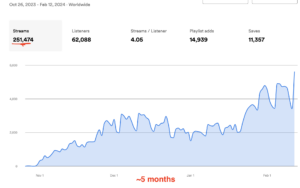What do you see when you look at a musical sheet?
Some musicians will automatically start translating written notes into sounds, while others will never learn the secrets of note reading and, nonetheless, have a successful and satisfying music career.
I only started learning how to read and write music after years of playing with many bands and various genres, so it took me a while to realize that being able to transform sounds into a common language is a crucial skill to have.
Nowadays, music transcription websites can greatly simplify the process of translating your music into shareable musical sheets, opening up a whole new world for your music and creativity. So, today we’ll take a look at the world of music transcription and those websites that can bring your sonic visions to life.
So, what exactly is music transcription?
In Western tradition, music transcription refers to a process of listening and analyzing an acoustic signal and transforming it into written or symbolic form. It involves identifying characteristics such as the pitch, duration, onset time, and source of each sound in a piece of music. It’s often considered, together with music theory and ear training, a part of classical music studies (and the one that music students dread the most.)
A complete transcription, requiring that all elements (pitch, instruments, and timing) are deciphered, is often very complex or almost impossible; hence, the ultimate goal is to transcribe as much sonic information in a piece as possible or just its most distinctive parts, e.g., the dominant melody or a drum part.
There are many reasons why you may want to transcribe a piece of music, and the most common are learning and education, adapting music for different instruments and ensembles, promotion and music production, protecting your copyrights by providing a written “proof” of your music or preserving sounds that exist only in the form of audio recording.
In 2023, you don’t need to master the skill of music transcription, as many transcription websites will complete the job for you.
Now, I’ll dive into the world of music transcription websites and provide you with a list of the best services out there. Most of them work entirely online, and others you will need to download on your device to take full advantage of.
Whether you are trying to learn a new song that you cannot find the notes for, transpose the key up or down to play a track with your band or create music notes of your own composition, using one of these websites will save you tons of time and hassle.
Let’s check them out!
Soundslice
Soundslice is a web-based notation and tablature editor that combines music notation with performance audio and video in a single interface.
It’s a great tool to practice, transcribe existing audio, and use in educational settings. Soundslice provides a range of intuitive tools: it allows you to automatically go to a related moment in a video by clicking on a note or to create loops, transpose, play solo parts, and slow down. Synchronization lets you download music directly from programs like Guitar Pro, MusicXML, and others.
Soundslice works entirely in a web browser, and it can be used on any device (mobile, tablet, desktop) without installing anything. All your work is saved in the cloud storage.
Price: Soundslice offers four plans, and it also has a free version. Free plan functions as a simple web-based notation/tab editor, and it has YouTube sync. The Plus for $5/month is a good choice for a student, as you can easily share your notations and sync with uploaded MP3s/video files. The Teacher Plan costs $20/month, and for this price, you can have up to 100 students and each additional student costs 20¢/month. With this plan, you can organize private courses, and it also includes API access.
Pros:
- Affordable
- No need to download anything; it works entirely online.
- Sync with real recordings.
- API access.
Cons:
- Limited control over engraving.
Noteflight
Noteflight is an online music notation service that lets you create, view, print, and hear music notation in your browser.
The Basic version allows you to create and share up to 10 scores. You can also import and export files in MIDI and Music XML formats. On top of that, you get access to online community groups and collaboration tools.
If you need something more advanced, Noteflight Premium has the ability to create and share unlimited scores. You can also sell your scores on Noteflight Marketplace. Some cool premium features include the ability to record audio into scores, intuitive transposition, transcription with MIDI instruments in real time, and access to over 85 high-quality instruments for premium playback.
Noteflight Learn, as you may have guessed, has been created to support music education professionals: it’s ideal for teachers, music educators, and learners. The service provides a COPPA-compliant website designed specifically for teaching music and includes all premium feathers. Compatible with Google Classroom and Learning Management Systems, Noteflight is a great solution to work with students in an efficient and secure way. As add-ons, you can get access to Hal Leonard’s digital library of over 85,000 sheet music titles and SoundCheck Performance Assistant.
Finally, on Noteflight Marketplace, you can sell, purchase, and print music scores: it has a wide range of legal, copyrighted, and open-domain music sheets and is compatible with all plans. It’s a great option, which also makes Notflight worth checking out.
Price: The basic version is free to use, provided you create an account. Noteflight Premium is available for $7.95/month or $49/year. There is also a lifetime purchase option for $299. Noteflight Learn’s price starts from $69/year, and it has a 60-day trial for up to 50 users.
Pros:
- The ability to purchase and sell music notes on Notion Marketplace.
- Free version available.
- You scan music into Noteflight as a MusicXML file.
Cons:
- Takes a bit longer to get a grip on all the premium functions.
Flat.io
Flat.io is an online music notation software that helps you write music scores in your web browser through a number of collaborative features and a simple, clean, and user-friendly interface. Thanks to Flat.io, you can edit, make notations, and listen to audio results in your browser. A decent amount of features included in the free version make it an accessible tool for students and musicians on a budget.
Flat.io has an intuitive and accessible menu, making it enjoyable to explore what the platform has to offer. A useful perk is that it displays shortcuts when hovering over each option, which helps you quickly learn how to use the platform faster.
The free version of Flat.io is one of the most comprehensive free tools out there, and it allows you to make notations working with your MIDI device, add as many instruments as you like, or change note beaming. That said, on a free plan, you are limited to working with a maximum of 6-8 staves, which automatically minimizes the number of instruments you can implement. On the downside, there are some reviews online pointing out some inaccuracies in notations, and it doesn’t give you the option to edit the scores once you spot a mistake.
Still, it’s one of the best and most affordable music notation websites, and its free version is great, comparable only with MuseScore.
Price: Flat Power costs $9.99/month or $49/year. You can also get a lifetime access for $199. Flat for Education costs $2 per user for a minimum of 50 users. It has a 90-day trial, which is long enough to check if the platform is right for what you need.
MuseScore
The only completely free and open-source option on the list, MuseScore, has a clear and user-friendly interface, allowing you to take advantage of many features available often with premium paid software. While MuseScore is also a downloadable software, it offers an online platform where users can share and collaborate on transcriptions, which is why I thought it worth including it on the list.
MuseScore’s active community of musicians has shared millions of tracks online, bringing to life one of the most vibrant creative ecosystems of musicians transcribing music.
It’s also worth mentioning that MuseScore allows you to add notes to the sheet music without a MIDI keyboard, just with mouse and keyboard shortcuts. MuseScore doesn’t let you transform audio files into MIDI files, but you can import MusicXML, MIDI, and other formats from other programs and export them in audio and graphic files.
MuseScore4 included a number of updates, like Live Braille Viewer, developed to let blind users read music and collaborate online with other visually impaired musicians.
MuseScore is available on Mac, Windows, and Linux.
Price: Free
Pros:
- Free and open-source platform.
- Various input and output options.
- Clear and intuitive design.
- Multiple plugins available.
- Community functions.
- Lightweight.
Cons:
- Doesn’t support audio file import.
- No volume editing.
My Sheet Music Transcriptions
Created by pianist and engineer Oriol López Calle, My Sheet Music Transcriptions is one of the most popular websites specializing in music transcription, arrangement creation, and score digitization.
My Sheet Music Transcription differs from the websites listed above, as instead of using technology to transcribe music, it employs over 30 experienced music professionals who handle clients’ orders daily. Relying on music notation programs, like Sibelius or MuseScore, they provide personalized service for each project.
Since its launch, they have created over 27,000 scores and worked with over 10,000 customers worldwide, scoring high on TrustPilot (4.9 out of 261 reviews). The website is available in four languages: English, French, Spanish, and Japanese.
Price: My Sheet Music Transcription offers a wide array of payment plans for pianos and other instruments, which also vary based on genre. The prices start from $21/minute of audio for simple piano compositions and $12/minute for instrumental compositions. They have different rates for vocals, jazz compositions, guitar tabs, and more. You can also get a personalized quote for more complex orders.
Pros:
- Personalized transcription service provided by trained professionals.
- High-quality and accurate transcriptions.
Cons:
- Less affordable than automated services.
Transcribe!
Transcribe! is another excellent tool used for music transcription. While not an automatic transcription service per se, this specialized, high-quality music player is used by musicians worldwide to create digital notes of an audio recording. Transcribe! is a downloadable application, but it offers web-based resources and can be run on a web platform for analyzing and transcribing audio.
Transcribe! has several optimization options and allows musicians to play pieces of audio on a loop to support the transcription process. You can also place markers on audio, displayed in a scrollable waveform, to easily return to a specific part. It doesn’t support MIDI files and instead works with audio sample data files.
Transcribe! Can play and record audio and apply various effects such as speed change, pitch change, and EQ, and allows you to save edited files in the app.
Other than traditional transcription, it can be used for play-along practice and speech transcription. While Transcribe! is a great tool, you need to keep in mind that it’s not a transcribing software, and you need to already have some music transcription knowledge to be able to use it. But if you do, it can be an invaluable source of inspiration.
Transcribe! app is available to download on Mac, Linux, and Windows. It has a 30-day free trial period, after which you need to purchase it if you want to continue using it.
Price: $39 per copy after 30-day trial. Price gets lower if you are an organization that purchases more than one copy (license).
Pros:
- Ability to erase vocals from audio recordings.
- Allows to loop sections of the track.
- Integrated piano keyboard.
- Video file display.
- Ability to change key and speed
Cons:
- It doesn’t support MIDI files.
Final notes
I hope these websites will help you transcribe music fast and effectively! Not all the websites mentioned above work in the same way, so make sure you analyze each option and choose the one that meets your requirements.
You may find that some are more accurate than others, but once you understand how they work, these quality websites will make your job much easier. The most sophisticated tools will be able to manage complex musical compositions with multiple instruments, from jazz to orchestra and anything in between.
If you’re a music student, teacher, musician, or composer, using transcription websites will help you with the most time-consuming tasks while allowing you to focus on your creativity.
Good luck!









